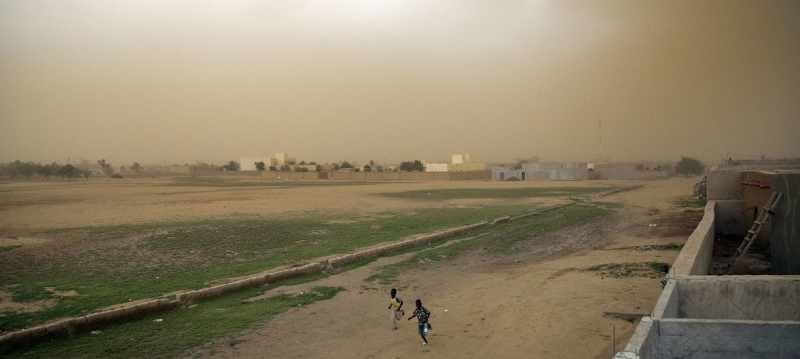- Security Council Divided on United States' Venezuela Action |
- Over 1.53m voters register for postal balloting: Shafiqul Alam |
- Bangladesh Bank to liquidate 9 NBFIs in financial sector reforms |
- Govt Moves to Clear Tk20,000cr Dues to Avoid Summer Outages |
- Maduro Pleads Not Guilty in US Court, Claims Presidency |
Sand and Dust Storms Wreak Havoc Across Borders

Children run from an approaching sand storm in Gao, Mali.
There are three Great Pyramids at Giza in Egypt – but imagine if there were 307 of these mighty edifices. Now imagine they had dissolved into over two billion tons of sand and dust particles.
That’s how much sand and dust enters the atmosphere annually, according to the World Meteorological Organization (WMO)’s annual report on storms that scatter such particles across borders worldwide.
The UN weather agency’s report warns that although the amount of dust decreased marginally in 2024, the impact on human health and economies is growing.
WMO estimates that over 330 million people across 150 countries are affected by sand and dust storms, leading to premature deaths, health consequences, and steep economic costs.
“Sand and dust storms do not just mean dirty windows and hazy skies. They harm the health and quality of life of millions of people and cost millions of dollars,” said Celeste Saulo, Secretary-General of the WMO.
While the movement of sand and dust is a natural weather process, increased land degradation and poor water management over recent decades have worsened their prevalence and geographic spread.
Dust and sand particles – 80 per cent of which come from North Africa and the Middle East – can travel thousands of kilometres across borders and oceans.
“What begins in a storm in the Sahara can darken skies in Europe. What is lifted in Central Asia can alter air quality in China. The atmosphere does not recognize borders,” said Sara Basart, WMO Scientific Officer, during a briefing in Geneva.
This is precisely what happened in 2024: dust and sand from the Western Sahara travelled to Spain’s Canary Islands, while fierce winds and drought in Mongolia carried dust to Beijing and northern China.
“These extreme weather events are not local anomalies. Sand and dust storms are fast becoming one of the most overlooked yet far-reaching global challenges of our time,” said a senior official on Thursday, speaking on behalf of Philémon Yang, President of the General Assembly.
The storms can block sunlight and disrupt ecosystems on land and in oceans. In addition to environmental impacts, these weather events profoundly affect human health and economic stability.
“Once considered seasonal or localised, sand and dust storms have escalated into a persistent and intensifying global hazard,” said Rola Dashti, co-chair of the UN Coalition on Combating Sand and Dust Storms.
Between 2018 and 2022, more than 3.8 billion people were exposed to dust particles, with the worst-hit regions experiencing exposure 87 per cent of the time.
These particles worsen cardiovascular disease and other health issues, leading to seven million premature deaths each year, particularly among vulnerable populations.
Mr. Yang referred to this as the “staggering human toll”. From an economic standpoint, storms can cause up to a 20 per cent drop in crop production among rural communities, pushing them towards hunger and poverty.
In the Middle East and North Africa alone, economic losses in 2024 due to sand and dust storms accounted for 2.5 per cent of the region’s GDP.
The WMO is calling on the international community to invest more in early warning systems and data tracking.
“No country, no matter how prepared, can face this challenge alone. Sand and dust storms are a transboundary threat that demands coordinated, multisectoral and multilateral action,” said Ms. Dashti.
With 2025–2034 declared the Decade on Combating Sand and Dust Storms, Mr. Yang said this must be a turning point. He urged Member States to move from awareness to action – and from fragmentation to coordination.

